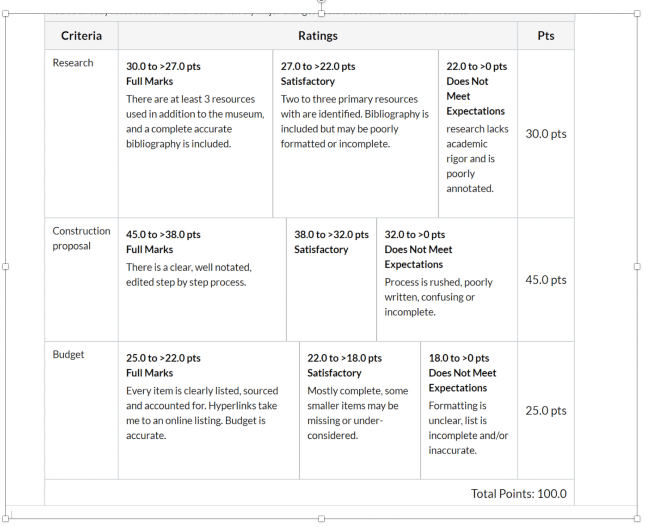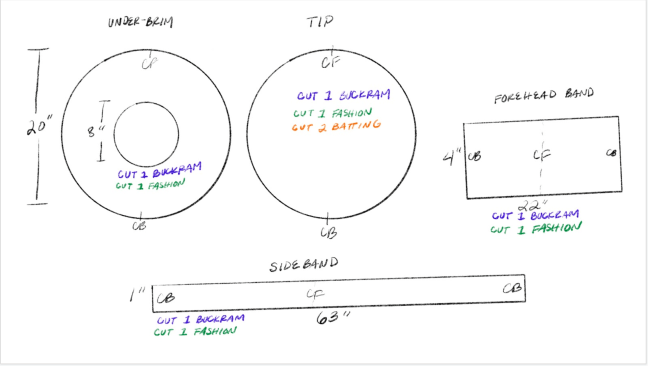Submitted by Christianne Myers, University of Michigan, Ann Arbor
Abstract
This research project introduces students to using digital museum collections, project management and budgeting. Using a museum artifact, students propose a step-by-step build process for adapting the artifact for stage purposes, provide working drawings, and source the materials with an estimated budget.
Length of Activity
Week Long Project
Area of Technical Theatre
- Costume Design
- Costume Technology
Activity Objectives
Purpose:
- Plan & research a Non-Western headdress, hat, or piece of headgear
- Think creatively how to replicate such an artifact for stage
Skills:
- Implement historical, Non-Western Research
- Create a budget
- Project management
Knowledge:
- Understand the time, details, & considerations in making a costume piece for stage
- Collecting, organizing & contextualizing research
- Define the steps in planning & budgeting a project
Description
Method:
Visit this online portfolio from UMMA. (or another curated list from a museum)
Begin by selecting a piece of headgear from a museum collection or ArtStor. None of these pieces are stage worthy, nor would they likely be stage worthy if found new. (Faculty should curate a portfolio of artifacts to choose from). First, select one piece that interests you. Then, complete the following aspects to this assignment:
1) Additional research All research must be primary or secondary.
The goal isn’t to find exact replicas of the headgear, but rather other headgear from or near the same geographical area. Discover the materials used in those areas. Plant based? Animal based? Molded or woven, or ??? Study your headpiece, look at photos, and draw some conclusions. If you can find an extant description, great! Also, find one or two examples of what the rest of the body adornment/regalia/attire might look like. Many times, when researching a show, we have to make an educated guess. Find as many clues as possible and complete the picture. Give the headgear some context. What is the use of the piece? What are the circumstances for it being worn?
2) Construction proposal Describe how you would replicate this hat for the stage.
- Describe how you would replicate this hat for the stage. Could you start with a found object or thrift store purchase as a base?
- If so, it would need to be reinforced and stabilized.
- Think of hidden hat bands that support the exterior shape, or the guts from a bike helmet, or lining something loosely woven with glued down felt, or using a fascinator base.
- Can an intricately woven pattern or applique be replicated with a less time consuming paint treatment?
- Are there edges that should be wired?
Develop simple working line drawings in two or three views and an x-ray view to illustrate the construction details. Draw any decorative detail “swatches.” Organize the project and write a step by step process. The expectation for granularity of this portion should be determined based on how much time is expected for the students to work on the assignment.
3) Budget your project
Based on internet resources, budget & source the materials for the project. Create a spreadsheet and be specific. For small amounts of consumables (like glue or thread), they should be listed, but assume they are on hand as part of shop supplies. Roam Amazon, or a hardware store, or other non-traditional sources. Look here for millinery supply prices: http://www/hatsupply.com, http://www.judithm.com
Time Required
This is a one week independent exercise. It can work well for remote/asynchronous teaching.
Required Materials
Internet access for viewing museum collection OR curated access to museum study case. Basic word processing program and simply drawing tools for process drawings (could be pencil and paper, could be ProCreate or Sketchbook). If working remotely, access to a method of scanning/photographing and uploading any non-digital renderings will be necessary.
Adaptation
Could expand to non-millinery projects. Props, Armor, etc…
Evaluation

Additional written comments were specific notes on their proposed process and working drawings.
Below is an Example of A Student Project
by Carly Behrendt




















